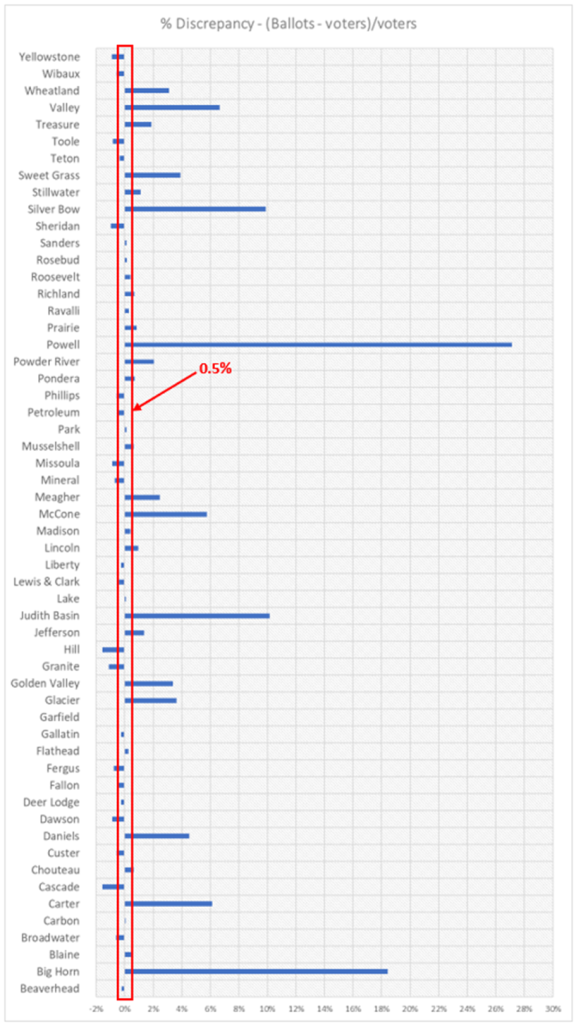
Please Follow us on Gab, Minds, Telegram, Rumble, Gettr, Truth Social, Twitter
On August 20th, during an interview with Aaron Flint of Montana Talks, Senator Theresa Manzella credited the recount of Silver Bow County’s 2024 primary election, which was then currently underway, to a group of “concerned citizens” who had pointed out a large apparent discrepancy between the number of ballots counted and the number of voters who were credited with votes in that election in Silver Bow County. Thus, a previously no-name group of loosely affiliated patriots around the state seems to have gained a name, the Concerned Citizens of Montana.
Many of these concerned citizens had previously been associated with the Montana Election Integrity Project (MEIP), founded by the late Jane Rectenwald in early 2021. One of the achievements of MEIP was an extensive canvassing in six counties of voters who participated in the 2020 election. Beginning in the middle of the winter, volunteers knocked on the doors of thousands of voters in these counties, asking if the registered voters lived there, and if so, had they voted and in what manner. The resulting canvassing report, which should have raised serious concerns, was totally ignored by our Secretary of State. You can access this report here: https://mtelectionintegrity.org/canvass.
Though many were discouraged by this lack of response and no longer have faith that election integrity can be achieved in Montana, as the importance of the 2024 general election became increasingly significant, many began to reconnect. They began working together to do whatever they could to ensure the security and validity of the 2024 election in Montana. In January 2024, donations from within the group allowed the purchase of a subscription to the Montana voter rolls, which allows unlimited downloads of the currently registered voters, and their voting history. Beginning in April, well before the primary date, and up to the present day, the voter roll data was downloaded daily. As the voting histories began to show accepted absentee ballots for the primary in late April, gradually the list of registered voters who voted in this election began to grow. It continued to grow until the date of the primary, after which votes for in-person voters began to show up in their voting histories. For several weeks after the election, absentee ballots received on election day continued to be processed and shown as accepted in the associated voters’ voting histories, and those who voted in-person continued to be credited with their votes. Because of the information acquired daily, records of voting could include those who voted, but afterwards were removed from the voter rolls because of death or other reasons. Eventually newly credited votes slowed down to a trickle, and this allowed the totals of those who voted in the election to be compared to the turnouts (ballots counted) which were published in the SOS website. And the results were shocking!

There is no Montana law at present which sets a limit on the allowable difference between the number of ballots counted and the number of voters who voted. However, there is a law that requires the votes being manually counted during the post-election audits to agree with the number of votes counted by our tabulators within 0.5% for the counties to certify their elections. If this is considered a reasonable standard and is applied to the ballots/voter discrepancies, only 18 of Montana’s 56 counties met these criteria. In some counties, fewer ballots were counted than voters who voted, but by far the worst problem was counties who counted more ballots than the number of voters who voted.
Though Silver Bow County had only the 4th largest percentage discrepancy, because it had the highest number of voters, it had the largest discrepancy. 1,085 more ballots were counted than there were voters who voted. Eighty-two of these were associated with in-person & provisional voters, and 1,003 with absentee voters.
A meeting was held with the Silver Bow County election administrator, Linda Sajor-Joyce. Upon reviewing this data, she was equally concerned, especially because the election had already been certified. After rechecking all the numbers, she decided it was possible that election results could have been affected, and that a recount would be needed.
To access the ballots, a court order was needed and was obtained. First, the number of ballot envelopes were counted for each precinct, and the number of in-person voters were checked via the poll books. The number of ballots in each precinct were manually counted on Monday, August 19th, and the ballots were run through the tabulators the following day to recount the votes for all the races and initiatives.
The President of Montana’s Senate, Jason Ellsworth, decided it was necessary for the Senate to send a team down to observe the recount proceedings. The team that attended included Senators Theresa Manzella, Mike Cuffe, Edie McClafferty, Shelley Vance, and Ryan Lynch. The SOS Director of Elections, Austin James also attended. He had played a major role in getting approval for the court order.
The results of the recount have not yet been made available as of this writing but should soon be. And the actions to be taken regarding the other counties with major discrepancies have yet to be determined. Stay tuned!